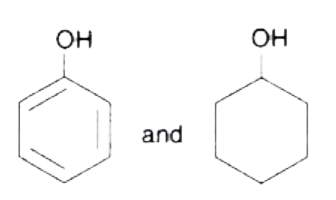Give a chemical test to distinguish between the following:
Liquid ammonia and liquor ammonia fortis.
To distinguish between liquid ammonia and liquor ammonia fortis, we can perform a simple chemical test using anhydrous copper sulfate (CuSO4). Here’s a step-by-step solution:
Step 1: Understand the Composition
- Liquid Ammonia: This is pure ammonia in its liquid state and does not contain water.
- Liquor Ammonia Fortis: This is a solution of ammonia in water, meaning it contains both ammonia and water.
Step 2: Prepare the Test
- Take two separate test tubes.
- In one test tube, add a few drops of liquid ammonia.
- In the other test tube, add a few drops of liquor ammonia fortis.
Step 3: Add Anhydrous Copper Sulfate
- To both test tubes, add a small amount of anhydrous copper sulfate (CuSO4), which is white in color.
Step 4: Observe the Reaction
- For Liquid Ammonia: The anhydrous copper sulfate will remain white because there is no water present to react with it.
- For Liquor Ammonia Fortis: The anhydrous copper sulfate will turn blue. This occurs because the water in liquor ammonia fortis reacts with copper sulfate to form hydrated copper sulfate (CuSO4·5H2O), which is blue in color.
Conclusion
- If the solution remains white, it is liquid ammonia.
- If the solution turns blue, it is liquor ammonia fortis.
Summary of the Test
- Test Substance: Anhydrous copper sulfate (CuSO4)
- Observation:
- White (no water) → Liquid Ammonia
- Blue (presence of water) → Liquor Ammonia Fortis
---
- Liquid Ammonia: This is pure ammonia in its liquid state and does not contain water.
- Liquor Ammonia Fortis: This is a solution of ammonia in water, meaning it contains both ammonia and water.
- Take two separate test tubes.
- In one test tube, add a few drops of liquid ammonia.
- In the other test tube, add a few drops of liquor ammonia fortis.
- To both test tubes, add a small amount of anhydrous copper sulfate (CuSO4), which is white in color.
- For Liquid Ammonia: The anhydrous copper sulfate will remain white because there is no water present to react with it.
- For Liquor Ammonia Fortis: The anhydrous copper sulfate will turn blue. This occurs because the water in liquor ammonia fortis reacts with copper sulfate to form hydrated copper sulfate (CuSO4·5H2O), which is blue in color.
- If the solution remains white, it is liquid ammonia.
- If the solution turns blue, it is liquor ammonia fortis.
- Test Substance: Anhydrous copper sulfate (CuSO4)
- Observation:
- White (no water) → Liquid Ammonia
- Blue (presence of water) → Liquor Ammonia Fortis
Topper's Solved these Questions
- STUDY OF COMPOUNDS OF NITROGEN- AMMONIA BOOK - ICSECHAPTER - STUDY OF COMPOUNDS OF NITROGEN- AMMONIA EXERCISE - Questions from Preivous ICSE Board Papers
77 Videos
- STUDY OF COMPOUNDS OF NITROGEN- AMMONIA BOOK - ICSECHAPTER - STUDY OF COMPOUNDS OF NITROGEN- AMMONIA EXERCISE - WORKSHEET - 2 (Give one word )
5 Videos
- STUDY OF COMPOUNDS OF NITROGEN - NITRIC ACIDBOOK - ICSECHAPTER - STUDY OF COMPOUNDS OF NITROGEN - NITRIC ACIDEXERCISE - QUESTIONS FROM PREVIOUS ICSE BOARD PAPERS
54 Videos
- SULPHURIC ACIDBOOK - ICSECHAPTER - SULPHURIC ACIDEXERCISE - QUESTIONS FROM PREVIOUS ICSE BOARD PAPERS (2018)
5 Videos
Similar Questions
Give chemical test to distinguish between

View SolutionGive a chemical test to distinguish between the following gases
NH3 and HCI
View SolutionGive a chemical test to distinguish between the following gases
HCI and CI2
View SolutionGive a chemical test to distinguish between the following gases
H2 and CO2
View SolutionGive a chemical test to distinguish between the following pairs of compounds:

View SolutionGive a chemical test to distinguish between the following gases
CO2 and SO2
View SolutionGive a chemical test to distinguish between the following:
Ferric salt and ferrous salt.
View SolutionGive a chemical test to distinguish between methanol and ethanol.
View SolutionGive a chemical test to distinguish between the following:
Sodium sulphate and ammonium sulphate.
View SolutionGive a chemical test to distinguish between the following:
Ammonium chloride and sodium chloride.
View Solution
